sensor PORSCHE PANAMERA 2010 1.G Information Manual
[x] Cancel search | Manufacturer: PORSCHE, Model Year: 2010, Model line: PANAMERA, Model: PORSCHE PANAMERA 2010 1.GPages: 80, PDF Size: 6.26 MB
Page 21 of 80
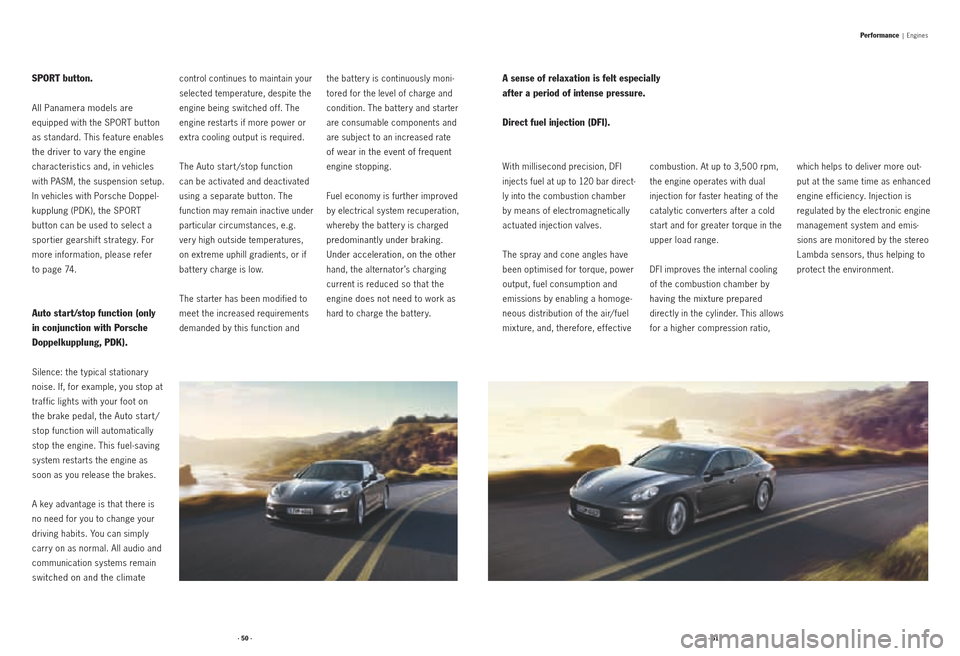
· 50 ·· 51 ·
SPORT button.
All Panamera models are
equipped with the SPORT but ton
as standard. This feature enables
the driver to vary the engine
characteristics and, in vehicles
with PASM, the suspension setup.
In vehicles with Porsche Doppel-
kupplung (PDK), the SPORT
but ton can be used to select a
sportier gearshif t strategy. For
more information, please refer
to page 74.
Auto start/stop function (only
in conjunction with Porsche
Doppelkupplung, PDK).
Silence: the t ypical stationary
noise. If, for example, you stop at
traf fic lights with your foot on
the brake pedal, the Auto start /
stop function will automatically
stop the engine. This fuel -saving
system restarts the engine as
soon as you release the brakes.
A key advantage is that there is
no need for you to change your
driving habits. You can simply
carry on as normal. All audio and
communication systems remain
switched on and the climate
control continues to maintain your
selected temperature, despite the
engine being switched of f. The
engine restarts if more power or
extra cooling output is required.
The Auto start /stop function
can be activated and deactivated
using a separate but ton. The
function may remain inactive under
particular circumstances, e.g.
very high outside temperatures,
on extreme uphill gradients, or if
bat tery charge is low.
The starter has been modified to
meet the increased requirements
demanded by this function and the bat tery is continuously moni
-
tored for the level of charge and
condition. The bat tery and starter
are consumable components and
are subject to an increased rate
of wear in the event of frequent
engine stopping.
Fuel economy is further improved
by electrical system recuperation,
whereby the bat tery is charged
predominantly under braking.
Under acceleration, on the other
hand, the alternator’s charging
current is reduced so that the
engine does not need to work as
hard to charge the bat tery.
Performance | Engines
With millisecond precision, DFI
injects fuel at up to 120 bar di rect -
l y
into the combustion chamber
by means of electromagnetically
actuated injection valves.
The spray and cone angles have
been optimised for torque, power
output, fuel consumption and
emissions by enabling a homoge -
neous distribution of the air/fuel
mixture, and, therefore, ef fective combustion. At up to 3,500 rpm,
the engine operates with dual
injection for faster heating of the
cataly tic converters af ter a cold
start and for greater torque in the
upper load range.
DFI improves the internal cooling
of the combustion chamber by
having the mixture prepared
direct
ly in the cylinder. This allows
for a higher compression ratio, which helps to deliver more out
-
put at the same time as enhanced
engine ef ficiency. Injection is
regulated by the electronic engine
management system and emis-
sions are monitored by the stereo
Lambda sensors, thus helping to
protect the environment.
A sense of relaxation is felt especially
after a period of intense pressure.
Direct fuel injection (DFI).
Page 26 of 80
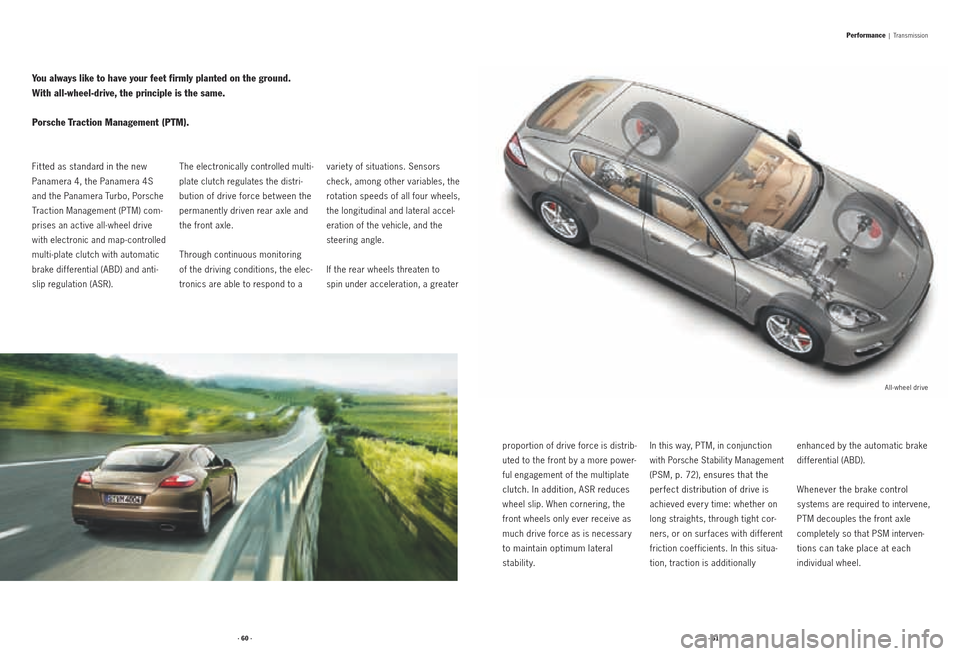
· 60 ·· 61 ·
All -wheel drive
Performance | Transmission
Fit ted as standard in the new
Panamera 4, the Panamera 4S
and the Panamera Turbo, Porsche
Traction Management (PTM) com -
prises an active all-wheel drive
with electronic and map-controlled
multi-plate clutch with automatic
brake differential (ABD) and anti -
slip regulation (ASR). The electronically controlled multi
-
plate clutch regulates the distri -
bution of drive force bet ween the
permanently driven rear axle and
the front axle.
Through continuous monitoring
of the driving conditions, the elec -
tronics are able to respond to a
variet y of situations. Sensors
check,
among other variables, the
rotation speeds of all four wheels,
the longitudinal and lateral accel -
eration of the vehicle, and the
steering angle.
If the rear wheels threaten to
spin under acceleration, a greater
proportion of drive force is distrib-
uted to the front by a more power -
ful engagement of the multiplate
clutch. In addition, ASR reduces
wheel slip. When cornering, the
front wheels only ever receive as
much drive force as is necessary
to maintain optimum lateral
stability. In this way, PTM, in conjunction
with Porsche Stabilit y Management
(PSM, p. 72), ensures that the
perfect distribution of drive is
achieved every time: whether on
long straights, through tight cor
-
ners, or on surfaces with dif ferent
friction coefficients. In this situa -
tion, traction is additionally enhanced by the automatic brake
differential (ABD).
Whenever the brake control
systems are required to intervene,
PTM decouples the front axle
completely so that PSM interven -
tions can take place at each
individual wheel.
You always like to have your feet firmly planted on the ground.
With all-wheel-drive, the principle is the same.
Porsche Traction Management (PTM).
Page 29 of 80
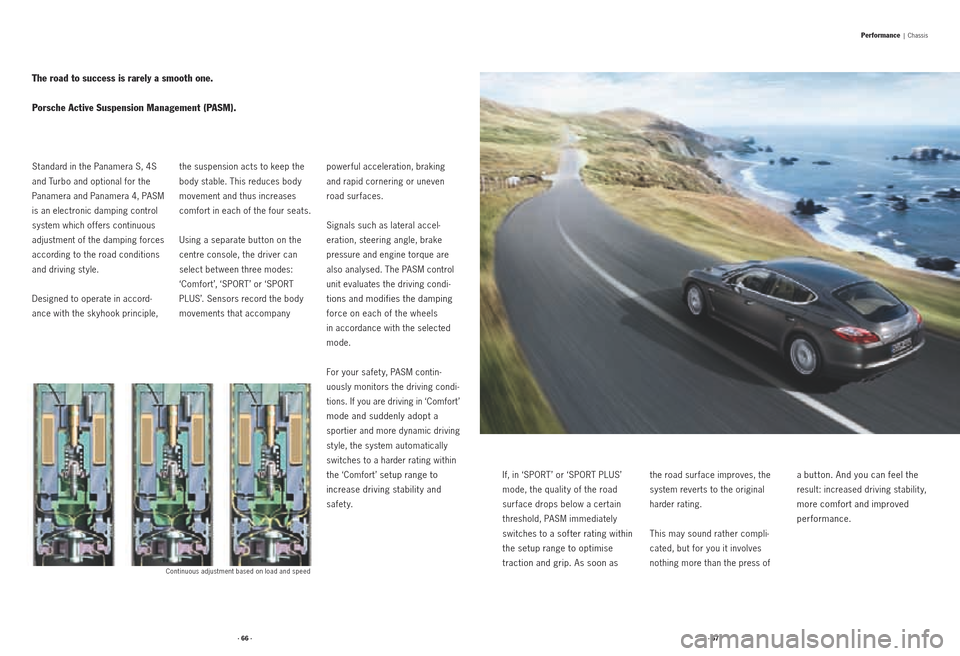
· 66 ·· 67 ·
Standard in the Panamera S, 4S
and Turbo and optional for the
Panamera and Panamera 4, PASM
is an electronic damping control
system which of fers continuous
adjustment of the damping forces
according to the road conditions
and driving st yle.
Designed to operate in accord-
ance with the skyhook principle, the suspension acts to keep the
body stable. This reduces body
movement and thus increases
comfort in each of the four seats.
Using a separate but ton on the
centre console, the driver can
select bet ween three modes:
‘Comfort ’, ‘SPORT’ or ‘SPORT
PLUS’. Sensors record the body
movements that accompany powerful acceleration, braking
and rapid cornering or uneven
road surfaces.
Signals such as lateral accel-
eration, steering angle, brake
pressure and engine torque are
also analysed. The PASM control
unit evaluates the driving condi
-
tions and modifies the damping
force on each of the wheels
in accordance with the selected
mode.
For your safet y, PASM contin -
uously monitors the driving condi -
tions. If you are driving in ‘Comfort ’
mode and suddenly adopt a
sportier and more dynamic driving
st yle, the system automatically
switches to a harder rating within
the ‘Comfort ’ setup range to
increase driving stabilit y and
safet y. If, in ‘SPORT’ or ‘SPORT PLUS’
mode, the qualit y of the road
sur face drops below a certain
threshold, PASM immediately
switches to
a softer rating within
the setup range to optimise
traction and grip. As soon as
the road surface improves, the
system reverts to the original
harder rating.
This may sound rather compli
-
cated, but for you it involves
nothing more than the press of a
but ton. And you can feel the
result: increased driving stabilit y,
more comfort and improved
performance.
Performance
| Chassis
The road to success is rarely a smooth one.
Porsche Active Suspension Management (PASM).
Continuous adjustment based on load and speed
Page 32 of 80
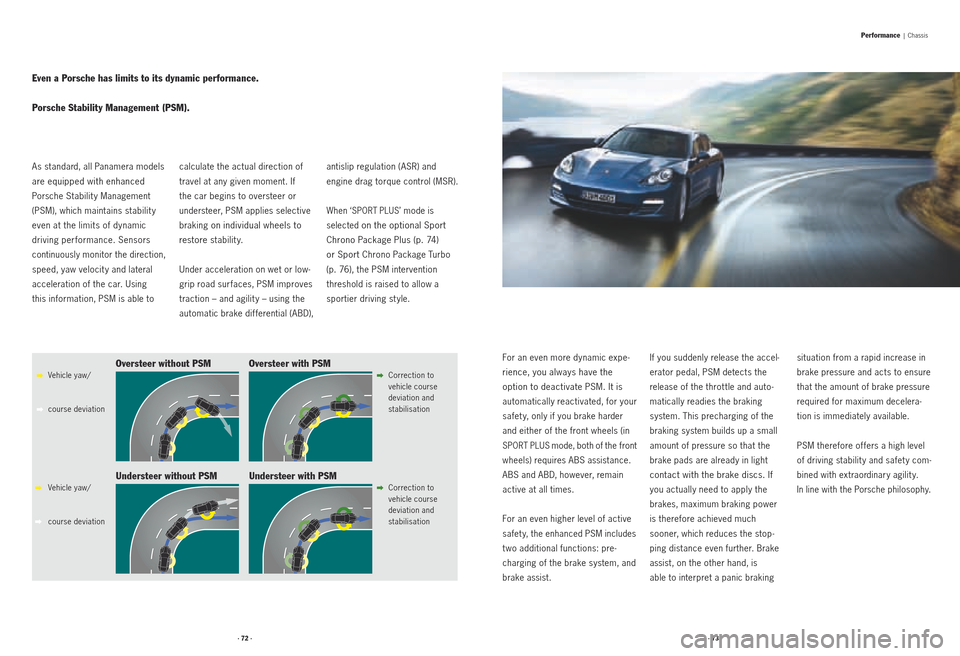
· 72 ·· 73 ·
Vehicle yaw/
course deviation
Vehicle yaw/
course deviationCorrection to
vehicle course
deviation and
stabilisation
Correction to
vehicle course
deviation and
stabilisationOversteer without PSM Oversteer with PSM
Understeer with PSM
Understeer without PSM
Performance | Chassis
As standard, all Panamera models
are equipped with enhanced
Porsche Stabilit y Management
(PSM), which maintains stabilit y
even at the limits of dynamic
driving per formance. Sensors
continuously monitor the direction,
speed, yaw velocit y and lateral
acceleration of the car. Using
this information, PSM is able to calculate the actual direction of
travel at any given moment. If
the car be gins to oversteer or
understeer, PSM applies selective
braking
on individual wheels to
restore
stabilit y.
Under acceleration on wet or low-
grip road surfaces, PSM improves
traction – and agilit y – using the
automatic brake dif ferential (ABD), antislip regulation (ASR) and
engine drag torque control (MSR).
When ‘SPORT PLUS’ mode is
selected
on the optional Sport
Chrono Package Plus (p. 74)
or Sport
Chrono Package Turbo
(p. 76), the PSM intervention
threshold is raised to allow a
sportier driving st yle.
For an even more dynamic expe-
rience, you always have the
option to deactivate PSM. It is
automatically reactivated, for your
safet y, only if you brake harder
and either of the front wheels (in
SPORT PLUS mode, both of the front
wheels) requires ABS assistance.
ABS and ABD, however, remain
active at all times.
For an even higher level of active
safet y, the enhanced PSM includes
t wo additional functions: pre -
charging of the brake system, and
brake assist. If you suddenly release the accel
-
erator pedal, PSM detects the
release of the throt tle and auto -
matically readies the braking
system. This precharging of the
braking system builds up a small
amount of pressure so that the
brake pads are already in light
contact with the brake discs. If
you actually need to apply the
brakes, maximum braking power
is therefore achieved much
sooner, which reduces the stop -
ping distance even further. Brake
assist, on the other hand, is
able to interpret a panic braking situation from a rapid increase in
brake pressure and acts to ensure
that the amount of brake pressure
required for maximum decelera
-
tion is immediately available.
PSM therefore of fers a high level
of driving stabilit y and safet y com -
bined with extraordinary agil
it y.
In line with the Porsche philosophy.
Even a Porsche has limits to its dynamic performance.
Porsche Stability Management (PSM).
Page 40 of 80
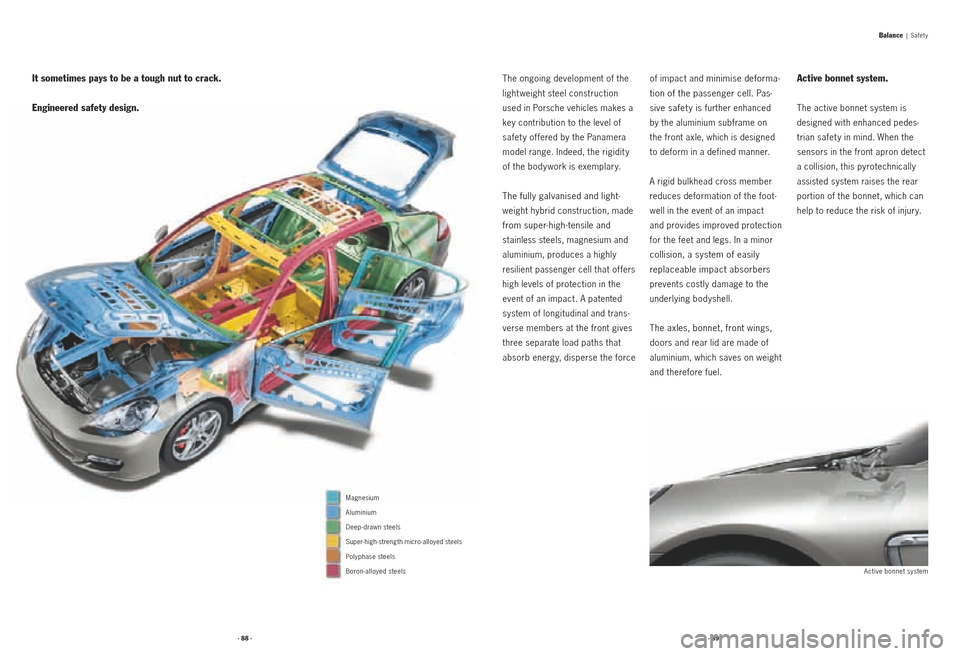
· 88 ·· 89 ·
of impact and minimise deforma-
tion of the passenger cell. Pas -
sive safet y is
further enhanced
by the aluminium
subframe on
the front axle, which is designed
to deform in a defined manner.
A rigid bulkhead cross member
reduces deformation of the foot -
well in the event of an impact
and provides improved protection
for the feet and legs. In a minor
collision, a system of easily
replaceable impact absorbers
prevents costly damage to the
underlying bodyshell.
The axles, bonnet, front wings,
doors and rear lid are made of
aluminium, which saves on weight
and therefore fuel.
Active bonnet system.
The active bonnet system is
designed with enhanced pedes-
trian safet y in mind. When the
sensors in the front apron detect
a collision, this pyrotechnically
assisted system raises the rear
portion of the bonnet, which can
help to reduce the risk of injury.
The ongoing development of the
light weight steel construction
used in Porsche vehicles makes a
key contribution to the level of
safet y of fered by the Panamera
model range. Indeed, the rigidit y
of the body work is exemplary.
The fully galvanised and light
-
weight hybrid construction, made
from super- high -tensile and
stainless steels, magnesium and
aluminium, produces a highly
resilient passenger cell that of fers
high levels of protection in the
event of an impact. A patented
system of longitudinal and trans -
verse members at the front gives
three separate load paths that
absorb energy, disperse the force
Magnesium
Aluminium
Deep-drawn steels
Super- high -streng th micro -alloyed steels
Polyphase steels
Boron-alloyed steels
Balance | Safet y
It sometimes pays to be a tough nut to crack.
Engineered safety design.
Active bonnet system
Page 41 of 80
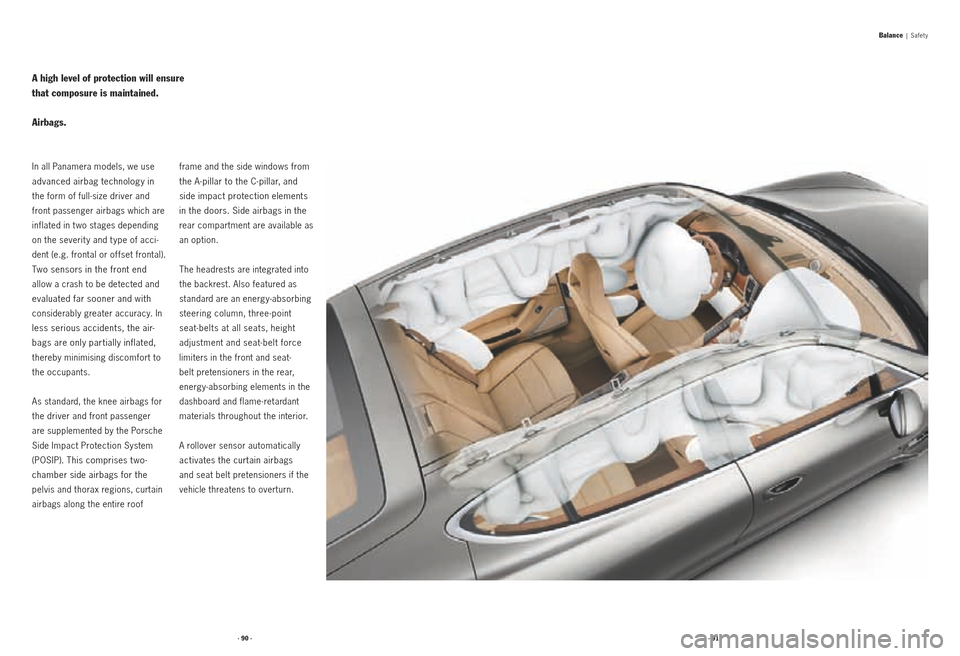
· 90 ·· 91 ·
A high level of protection will ensure
that composure is maintained.
Airbags.
frame and the side windows from
the A-pillar to the C-pillar, and
side impact protection elements
in the doors. Side airbags in the
rear compartment are available as
an option.
The headrests are integrated into
the backrest. Also featured as
standard are an energy-absorbing
steering column, three - point
seat-belts at all seats, height
adjustment and seat-belt force
limiters in the front and seat-
belt pretensioners in the rear,
energy-absorbing elements in the
dashboard and flame-retardant
materials throughout the interior.
A rollover sensor automatically
activates the curtain airbags
and seat belt pretensioners if the
vehicle threatens to overturn.
In all Panamera models, we use
advanced airbag technology in
the form of full-size driver and
front passenger airbags which are
inflated in t wo stages depending
on the severit y and t ype of acci
-
dent (e.g. frontal or of fset frontal).
Two sensors in the front end
allow a crash to be detected and
evaluated far sooner and with
considerably greater accuracy. In
less serious accidents, the air -
bags are only partially inflated,
thereby minimising discomfort to
the occupants.
As standard, the knee airbags for
the driver and front passenger
are supplemented by the Porsche
Side Impact Protection System
(POSIP). This comprises t wo -
chamber side airbags for the
pelvis and thorax regions, curtain
airbags along the entire roof
Balance | Safet y
Page 42 of 80
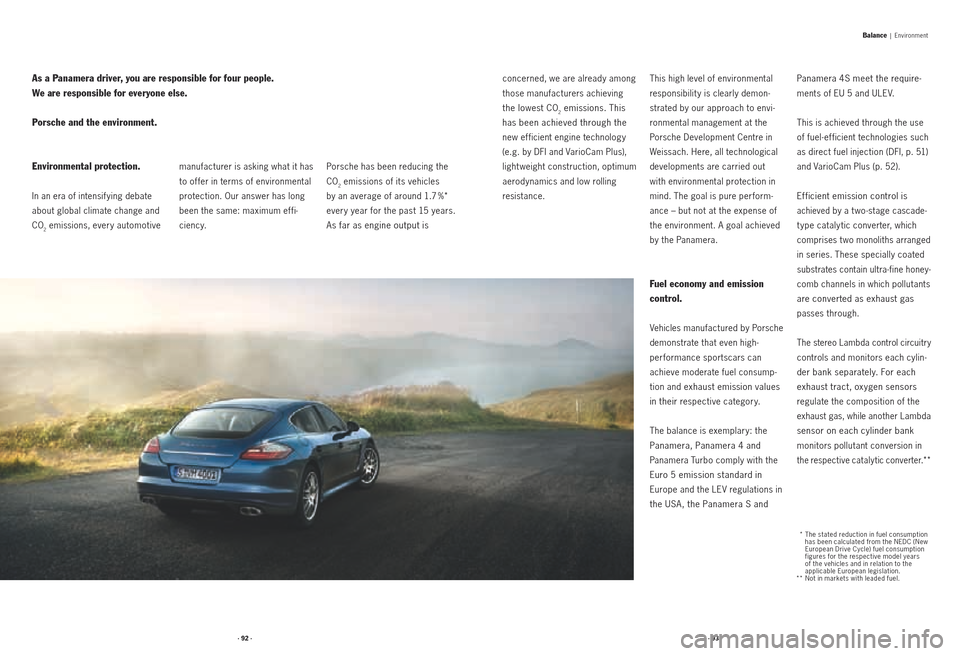
· 92 ·· 93 ·
concerned, we are already among
those manufacturers achieving
the lowest CO2 em issio ns. T h is
has been achieved through the
new ef ficient engine technology
(e.g. by DFI and VarioCam Plus),
light weight construction, optimum
aerodynamics and low rolling
resistance. This high level of environmental
responsibilit y is clearly demon
-
strated by our approach to envi -
ronmental management at the
Porsche Development Centre in
Weissach. Here, all technological
developments are carried out
with environmental protection in
mind. The goal is pure perform -
ance – but not at the expense of
the environment. A goal achieved
by the Panamera.
Fuel economy and emission
control.
Vehicles manufactured by Porsche
demonstrate that even high-
performance sportscars can
achieve moderate fuel consump -
tion and
exhaust emission values
in their
respective categor y.
The balance is exemplary: the
Panamera, Panamera 4 and
Panamera Turbo comply with the
Euro 5 emission standard in
Europe and the LEV regulations in
the USA, the Panamera S and
Panamera 4S meet the require -
ments of EU 5 and ULEV.
This is achieved through the use
of fuel- ef ficient technologies such
as direct fuel injection (DFI, p. 51)
and VarioCam Plus (p. 52).
Efficient emission control is
achieved by a t wo -stage cascade-
t ype cataly tic converter, which
comprises t wo monoliths arranged
in series. These specially coated
substrates contain ultra-fine honey -
comb
channels in which pollutants
are converted as exhaust gas
passes through.
The stereo Lambda control circuitr y
controls and monitors each cylin -
der bank separately. For each
exhaust tract, oxygen sensors
regulate the composition of the
exhaust gas, while another Lambda
s
ensor on each cylinder bank
monitors pollutant conversion in
the respective cataly tic converter.**
Environmental protection.
In an era of intensif ying debate
about global climate change and
CO
2 emissions, every automotive manufacturer is asking what it has
to of fer in terms of environmental
protection. Our answer has long
been the same: maximum effi
-
ciency. Porsche has been reducing the
CO
2 emissions of its vehicles
by an average of around 1.7 %*
every year for the past 15 years.
As far as engine output is
As a Panamera driver, you are responsible for four people.
We are responsible for everyone else.
Porsche and the environment.
Balance | Environment
* The stated reduction in fuel consumption
has been calculated from the NEDC (New
European Drive Cycle) fuel consumption
figures for the respective model years
of the vehicles and in relation to the
applicable European legislation.
** Not in markets with leaded fuel.
Page 56 of 80
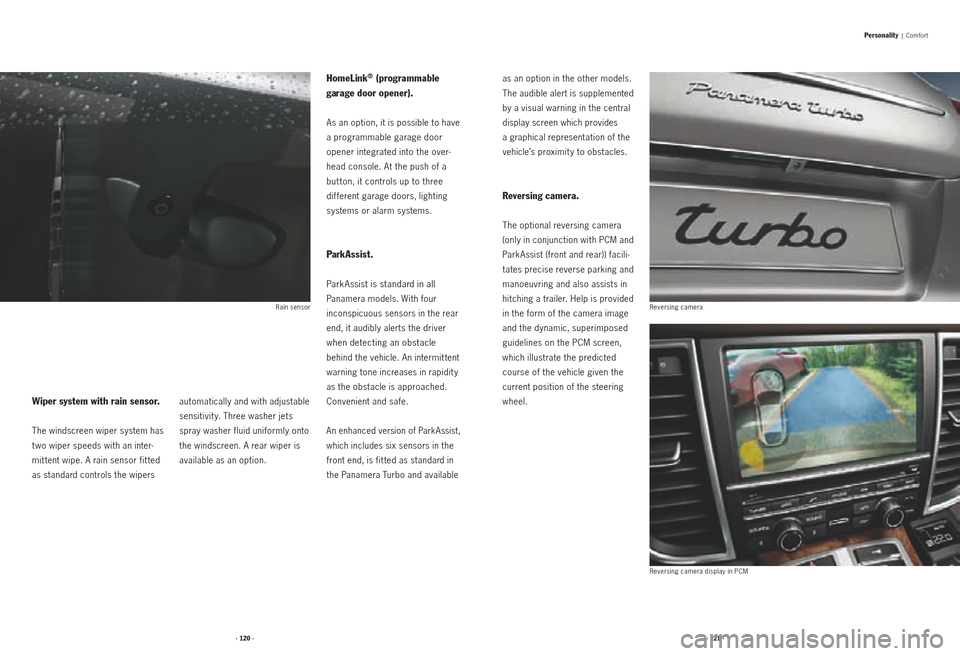
· 120 ·· 121 ·
Wiper system with rain sensor.
The windscreen wiper system has
t wo wiper speeds with an inter-
mit tent wipe. A rain sensor fit ted
as standard controls the wipers automatically and with adjustable
sensitivit y. Three washer jets
spray washer fluid uniformly onto
the windscreen. A rear wiper is
available as an option.
HomeLink® (programmable
garage door opener).
As an option, it is possible to have
a programmable garage door
opener integrated into the over-
head console. At the push of a
but ton, it controls up to three
dif ferent garage doors, lighting
systems or alarm systems.
ParkAssist.
Park Assist is standard in all
Panamera models. With four
inconspicuous sensors in the rear
end, it audibly alerts the driver
when detecting an obstacle
behind the vehicle. An intermit tent
warning tone increases in rapidit y
as the obstacle is approached.
Convenient and safe.
An enhanced version of ParkAssist,
which includes six sensors in the
front end, is fit ted as standard in
the Panamera Turbo and available as an option in the other models.
The audible alert is supplemented
by a visual warning in the central
display screen which provides
a graphical representation of the
vehicle’s proximit y to obstacles.
Reversing camera.
The optional reversing camera
(only in conjunction with PCM and
Park Assist (front and rear)) facili
-
tates precise reverse parking and
manoeuvring and also assists in
hitching a trailer. Help is provided
in the form of the camera image
and the dynamic, superimposed
guidelines on the PCM screen,
which illustrate the predicted
course of the vehicle given the
current position of the steering
wheel.
Personality | Comfort
Rain sensor Reversing camera
Reversing camera display in PCM
Page 57 of 80
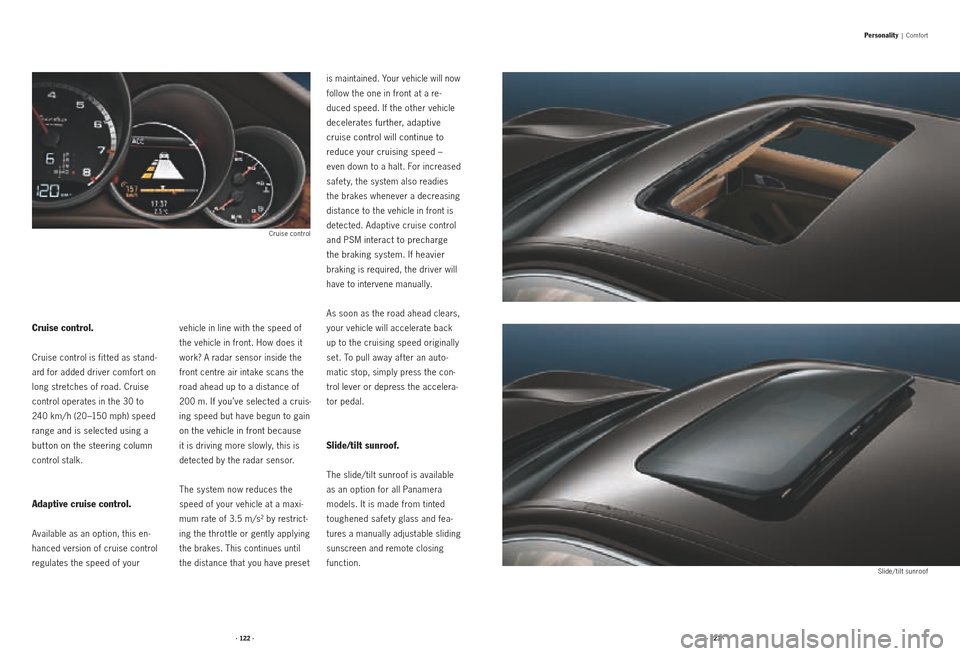
· 122 ·· 123 ·
Personality | Comfort
Cruise control.
Cruise control is fit ted as stand -
ard for added driver comfort on
long stretches of road. Cruise
control operates in the 30 to
240 km/ h (20 –150 mph) speed
range and is selected using a
but ton on the steering column
control stalk.
Adaptive cruise control.
Available as an option, this en -
hanced version of cruise control
regulates the speed of your vehicle in line with the speed of
the vehicle in front. How does it
work? A radar sensor inside the
front centre air intake scans the
road ahead up to a distance of
200 m.
If you’ve selected a cruis
-
ing
speed but have begun to gain
on
the vehicle in front because
it is driving more slowly, this is
detected by the radar sensor.
The system now reduces the
speed of your vehicle at a maxi -
mum rate of 3.5 m/s² by restrict -
ing the throt tle or gently applying
the brakes. This continues until
the distance that you have preset
is maintained. Your vehicle will now
follow the one in front at a re -
duced speed. If the other vehicle
decelerates further, adaptive
cruise control will continue to
reduce your cruising speed –
even down to a halt. For increased
safet y, the system also readies
the brakes whenever a decreasing
distance to the vehicle in front is
detected. Adaptive cruise control
and PSM interact to precharge
the braking system. If heavier
braking is required, the driver will
have to intervene manually.
As soon as the road ahead clears,
your vehicle will accelerate back
up to the cruising speed originally
set. To pull away af ter an auto -
matic stop, simply press the con -
trol lever or depress the accelera -
tor pedal.
Slide/tilt sunroof.
The slide/tilt sunroof is available
as an option for all Panamera
models. It is made from tinted
toughened safet y glass and fea -
tures a manually adjustable sliding
sunscreen and remote closing
function.
Cruise control
Slide/tilt sunroof
Page 78 of 80
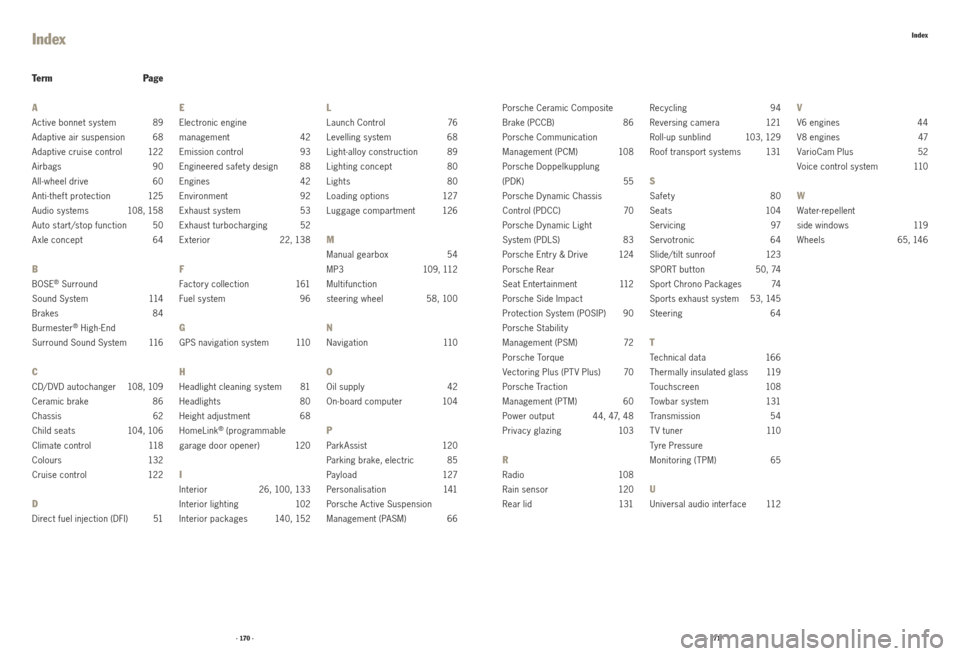
· 170 ·· 171 ·
Te r m Pa g e
A
Active bonnet system 89
Adaptive air suspension 68
Adaptive cruise control 122
Airbags 90
All-wheel drive 60
Anti-theft protection 125
Audio systems 108, 158
Auto start /stop function 50
A xle concept 64
B
BOSE® Surround
Sound System 114
Brakes 84
Burmester
® High - End
Surround Sound System 116
C
CD/ DVD autochanger 108, 109
Ceramic brake 86
Chassis 62
Child seats 104, 106
Climate control 118
C ol o u rs 132
Cruise control 122
D
Direct fuel injection (DFI) 51
E
Electronic engine
management 42
Emission control 93
Engineered safet y design 88
Engines 42
Environment 92
Exhaust system 53
Exhaust turbocharging 52
Exterior 22, 138
F
Factory collection 161
Fuel system 96
G
GPS navigation system 110
H
Headlight cleaning system 81
Headlights 80
Height adjustment 68
HomeLink
® (programmable
garage door opener) 120
I
Interior 26, 100, 133
Interior lighting 102
Interior packages 140, 152
L
Launch Control 76
Levelling system 68
Light-alloy construction 89
Lighting concept 80
Lights 80
Loading options 127
Luggage compartment 126
M
Manual gearbox 54
MP3 109, 112
Multifunction
steering wheel 58, 100
N
Navigation 110
O
Oil supply 42
On-board computer 104
P
Pa rk A ssist 120
Parking brake, electric 85
Pay l o a d 127
Personalisation 141
Porsche Active Suspension
Management (PASM) 66Porsche Ceramic Composite
Brake (PCCB)
86
Porsche Communication
Management (PCM) 108
Porsche Doppelkupplung
(PDK) 55
Porsche Dynamic Chassis
Control (PDCC) 70
Porsche Dynamic Light
System (PDLS) 83
Porsche Entry & Drive 124
Porsche Rear
Seat Entertainment 112
Porsche Side Impact
Protection System (POSIP) 90
Porsche Stabilit y
Management (PSM) 72
Porsche Torque
Vectoring Plus (PT V Plus) 70
Porsche Traction
Management (PTM) 60
Power output 44, 47, 48
Privacy glazing 103
R
Radio 108
Rain sensor 120
Rear lid 131Recycling
94
Reversing camera 121
Roll-up sunblind 103, 129
Roof transport systems 131
S
Safety 80
S e a t s 10 4
S e rv ici ng 97
Servotronic 64
Slide/tilt sunroof 123
SPORT but ton 50, 74
Sport Chrono Packages 74
Sports exhaust system 53, 145
Steering 64
T
Technical data 166
Thermally insulated glass 119
Touchscreen 108
Towbar system 131
Tra n s m i ssi o n 5 4
T V tuner 110
Tyre Pressure
Monitoring (TPM) 65
U
Universal audio interface 112
V
V6 engines 44
V8 engines 47
VarioCam Plus 52
Voice control system 110
W
Water-repellent
side windows 119
Wheels
6
5, 146
IndexIndex